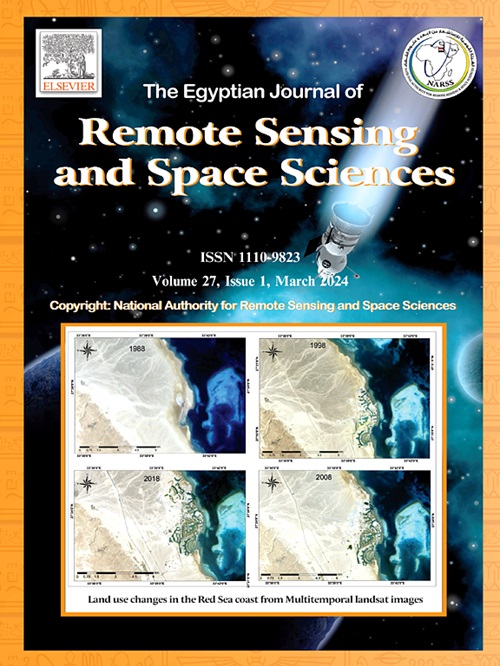Phenology-based winter wheat classification for crop growth monitoring using multi-temporal sentinel-2 satellite data
IF 4.1
3区 地球科学
Q2 ENVIRONMENTAL SCIENCES
Egyptian Journal of Remote Sensing and Space Sciences
Pub Date : 2024-10-18
DOI:10.1016/j.ejrs.2024.10.001
引用次数: 0
Abstract
Wheat is one of the most important staple crops consumed by more than four billion people in the world. However, its production is challenged by the impact of climate change which accounts for a 5.5 % reduction in wheat yield and it is predicted to dwindle further by about 30 % in 2050, due to trends in temperature, precipitation, and carbon dioxide. An effective annual crop estimate is necessary not only to inform governments the status of national food security, but also to determine the benchmark on which agricultural commodities are priced in the market. Thus, annual crop monitoring and yield estimate is paramount to determine the amount of wheat imports required to make up for the shortfalls in the national wheat production in South Africa, which has been a net importer of wheat since 1998. This study aimed at investigating the most distinguishable crop phenology for accurate winter wheat classification during the growing season from August – December 2020 using Sentinel-2 imageries and Random Forest algorithm. The winter wheat crop was more accurately identified during the crop ‘heading’ stage in October yielding the highest user’s (75.56 %) and producer’s (92.52 %) accuracies, despite the relatively lower overall accuracy (78.14 %) compared to that of December with overall accuracy of 83.58 % obtained during the maturity stage. This study, therefore, found that the extraction of NDVI values of the winter wheat crop over the period of the growing season using the Sentinel-2 NDVI series method and grouping these values into distinct classes using the K-means unsupervised clustering techniques assist to identify the different crop phenologies based on which the winter wheat crop could be detected and mapped accurately. The phenology-based classification of the winter wheat crop during the heading stage, reduce the ambiguity of spectral confusion created with surrounding grass and maize crops.
利用多时区哨兵-2 号卫星数据进行基于物候学的冬小麦分类以监测作物生长情况
小麦是全世界 40 多亿人消费的最重要的主食作物之一。然而,气候变化的影响使小麦减产 5.5%,预计到 2050 年,由于气温、降水和二氧化碳的变化趋势,小麦产量将进一步减少约 30%。有效的年度作物估产不仅是政府了解国家粮食安全状况的必要条件,也是确定农产品市场定价基准的必要条件。因此,年度作物监测和产量估算对于确定南非小麦进口量以弥补国家小麦产量不足至关重要,因为南非自 1998 年以来一直是小麦净进口国。本研究旨在利用哨兵-2 成像和随机森林算法,调查在 2020 年 8 月至 12 月的生长季节中最易区分的作物物候,以便对冬小麦进行准确分类。尽管总体准确率(78.14%)相对较低,但与 12 月份成熟期 83.58% 的总体准确率相比,10 月份作物 "打顶 "阶段对冬小麦作物的识别更为准确,用户准确率(75.56%)和生产者准确率(92.52%)最高。因此,本研究发现,使用 Sentinel-2 NDVI 系列方法提取冬小麦作物生长季节的 NDVI 值,并使用 K-means 无监督聚类技术将这些值分成不同的类别,有助于识别不同的作物物候,从而准确地检测和绘制冬小麦作物图。基于物候的冬小麦打顶期作物分类减少了与周围草地和玉米作物光谱混淆造成的模糊性。
本文章由计算机程序翻译,如有差异,请以英文原文为准。
求助全文
约1分钟内获得全文
求助全文
来源期刊
CiteScore
8.10
自引率
0.00%
发文量
85
审稿时长
48 weeks
期刊介绍:
The Egyptian Journal of Remote Sensing and Space Sciences (EJRS) encompasses a comprehensive range of topics within Remote Sensing, Geographic Information Systems (GIS), planetary geology, and space technology development, including theories, applications, and modeling. EJRS aims to disseminate high-quality, peer-reviewed research focusing on the advancement of remote sensing and GIS technologies and their practical applications for effective planning, sustainable development, and environmental resource conservation. The journal particularly welcomes innovative papers with broad scientific appeal.

 求助内容:
求助内容: 应助结果提醒方式:
应助结果提醒方式:


